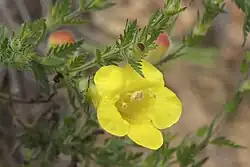Aureolaria pectinata
| Aureolaria pectinata | |
|---|---|

| |
| Scientific classification | |
| Kingdom: | Plantae |
| Clade: | Tracheophytes |
| Clade: | Angiosperms |
| Clade: | Eudicots |
| Clade: | Asterids |
| Order: | Lamiales |
| Family: | Orobanchaceae |
| Genus: | Aureolaria |
| Species: | A. pectinata
|
| Binomial name | |
| Aureolaria pectinata | |
Aureolaria pectinata, commonly called combleaf yellow false foxglove,[2] false foxglove,[3] and comb-leaf oakleach,[1] is a species of plant in the broomrape family that is native to the southeastern United States.[4]
It is an annual plant that produces yellow flowers in the late summer on herbaceous stems.[5] It possesses oppositely arranged, fern-like leaves.[6] It is hemiparasitic, meaning that it gets some of its nutrients from other plants. A. pectinata attaches itself to the roots of oak trees, explaining the common name "oakleach".[7]
Ecology
Habitat
A. pectinata is often found in communities such as upland hardwood forests, savannas, and pine communities.[8]
Phenology
The flowers of A. pectinata are bisexual and bloom from May to October.[9]
Fire Ecology
It has been observed that A. pectinata occurs in sites that have been burned, but not in sites that have not.[10]
Pollination, Herbivory, and Toxicology
A. pectinata has been observed to be pollinated by both bees and hummingbirds.[7]It serves as the larval host plant for Euphydryas phaeton.[7]
References
- ^ a b "NatureServe Explorer 2.0". explorer.natureserve.org.
- ^ NRCS. "Aureolaria pectinata". PLANTS Database. United States Department of Agriculture (USDA). Retrieved 19 April 2020.
- ^ "Aureolaria pectinata page". www.missouriplants.com.
- ^ Kartesz, John T. (2020). "Aureolaria pectinata". County-level distribution map from the North American Plant Atlas (NAPA). Biota of North America Program (BONAP).
- ^ "Aureolaria pectinata". Flora of Alabama. Retrieved 19 April 2020.
- ^ Radford, Albert Ernest; Ahles, Harry E.; Bell, Clyde Ritchie (1983). Manual of the vascular flora of the Carolinas (9. printing ed.). Chapel Hill, NC: Univ. of North Carolina Press. ISBN 978-0-8078-1087-3.
- ^ a b c "Know Your Natives – Yellow False Foxgloves". Arkansas Native Plant Society. 4 October 2014.
- ^ "Combleaf Yellow False Foxglove". Missouri Department of Conservation. Retrieved July 11, 2025.
- ^ "Know Your Natives – Yellow False Foxgloves". Arkansas Native Plant Society. October 3, 2014. Retrieved July 11, 2025.
- ^ Harrod, J.C.; Harmon, M.E.; White, P.S. (August 2000). "Post‐fire succession and 20th century reduction in fire frequency on xeric southern Appalachian sites". Journal of Vegetation Science. 11 (4): 465–472. doi:10.2307/3246576. ISSN 1100-9233.
